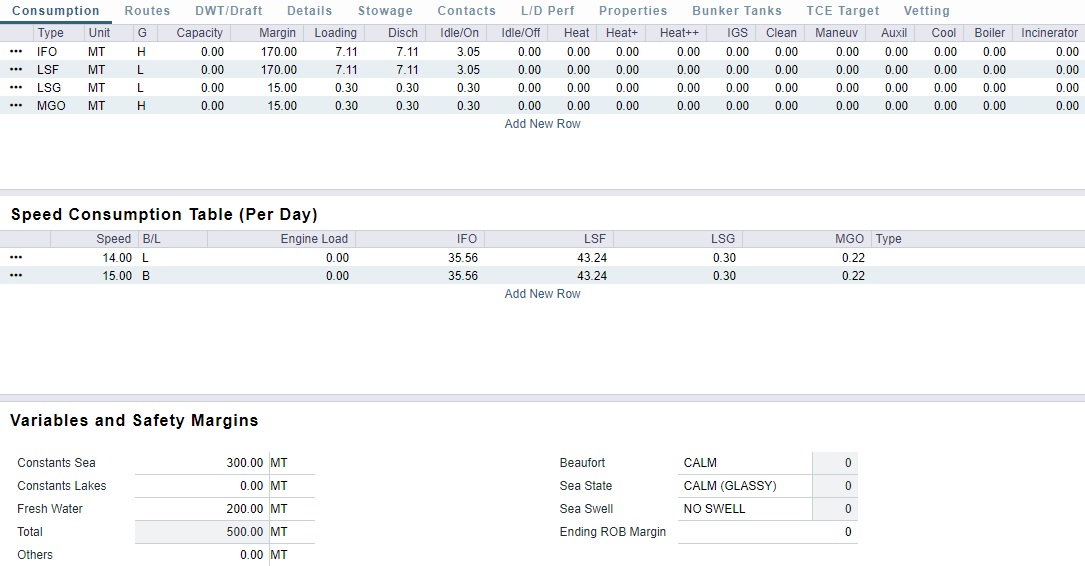IMOS - Consumption Tab - Vessel
Home > Data Center > Consumption Tab - Vessel
The Vessel Consumption tab includes the following sections:

In Port Consumption Table
This table represents the vessels' consumption of each fuel type. For non-LNG vessels, columns Type through Idle/Off are the most important to populate with values. The remaining fields are optional, and many of them are for reporting and informational purposes only.

Inactive: When a fuel type is no longer in use by the vessel, it cannot be deleted in an effort to maintain historical data integrity. Checking the “Inactive” box will remove this fuel type from future Estimates, Voyages, and Veslink Forms.
Type: Fuel Type, as defined in Fuel/Lube Types in the Data Center.
Unit: unit of measure, default is MT.
G: Fuel Grade.
G = General Purpose (can be used as either low or high sulfur fuel)
H = High Sulfur
L = Low Sulfur
Capacity: fuel capacity. If this value is exceeded on an Estimate or Voyage, users will receive a warning.
Margin: bunker safety margin. If the fuel level on an Estimate or Voyage is below this value, users will receive a warning.
Loading: daily consumption rate to be used for the vessel during loading activities.
Disch: daily consumption rate for the vessel during discharging activities.
Idle/On: Idling with the generator on. The daily consumption rate to be used for the vessel during non-working days in port (e.g., extra port days, idle days, etc.).
Idle/Off: idling with the generator off, for reporting and informational purposes only.
Heat: Heat fuel consumption (or reliquification for LNG carriers). This value is added to a vessel's daily consumption rate when heating consumption in the cargo bunkers tab of the CP terms is set to Heating or Reliq.
Heat+: LNG quantities that are boiled off then disposed on, for reporting and informational purposes only.
Heat++: flow meter adjustment that accounts for differences between crew and CTMS LNG readings, for reporting and informational purposes only.
IGS: This value is added to a vessel's daily consumption rate when IGS consumption in the cargo bunkers tab in the CP terms is set to Enabled.
Clean: This value is added to a vessel's daily consumption rate when Clean consumption in the cargo bunkers tab in the CP terms is set to one of the modes.
Maneuv: maneuvering fuel consumption, for reporting and informational purposes only.
Auxil: auxiliary engine fuel consumption, for reporting and informational purposes only.
Cool: this value is added to the vessel's daily consumption rate when Cooling consumption in the cargo bunkers tab of the CP terms is set to Enabled.
Boiler: boiler fuel consumption.
Incinerator: incinerator fuel consumption.
Notes about In Port Consumption
When adding a new Low-Sulfur fuel type to a Vessel that has an existing High-Sulfur type defined, Port/Sea Consumption rates default to being the same as the High Sulfur consumption rates if the new Low Sulfur fuel type is in the same Group as the High-Sulfur fuel type on the Fuel/Lube Types form.
When a Vessel Type is selected, and no fuel types are defined yet, the system defaults the Fuel Types, Units, and Grade according to the Vessel Type. If the vessel has not yet been used, changing the Vessel Type gives you the option to replace the existing fuel types with the default fuel types defined for the Vessel Type.
When the fuel type is H and an L fuel type exists in the vessel and is in the same Group on the Fuel/Lube Types form, you can copy consumption figures from the HS/LS corresponding fuel type. Right-click the Fuel Type and then click Copy consumption.
For LNG Vessels
Reliq, GCU/Steam, and Meter Adj consumption table columns replace Heat, Heat+, and Heat++.
You can include Bunker Curve Parameters in the calculation of fuel consumption.
Speed Consumption Table
This table represents the vessels at sea consumption basis speed. At a bare minimum, a speed for Ballast and for Laden must be entered. IMOS is able to extrapolate estimated at-sea consumption with just two values, but it will be most accurate with this table built out for varying speeds.

Speed: normal operating speed in knots used to determine consumption throughout a voyage.
B/L: Figures are separated into Ballast (B) and Laden (L).
Engine Load: engine load; for reporting and informational purposes only.
Fuel Types: The Fuel Type columns will pull from the lines in the In Port Consumption table, and the values represent the consumption rate for that specific fuel type based on the designated speed.
Type: consumption type of Eco, Input, or Warranted; for reporting and informational purposes only.
Notes about Speed Consumption
When the Vessel Type has Restrict Speeds enabled, the speeds available are only those corresponding to the specific Ballast/Laden mode.
In an Estimate or a Voyage, if the designated speed does not exist in the vessel details, the Veson IMOS Platform will linearly interpolate between the available consumption data within the Ballast and Laden categories.
If conflicted, the fuel grade from Fuel Zones in the Data Center takes priority over consumption.
To set specific speeds for different fuel modes and consumption types, you can add new entries to the Speed Consumption Table for Secondary Fuel Cons Modes in the Vessel form. When a speed consumption line is added as a non-default mode, the speed is reflected in Voyage or Estimate when the specific mode is assigned as a sea mode.
Variables and Safety Margins
Enter variables and safety margins for the vessel.
Beaufort, Sea State, and Sea Swell options are defined in the Data Center.
